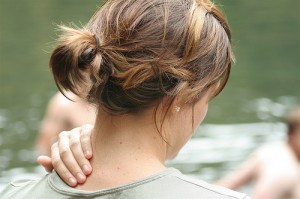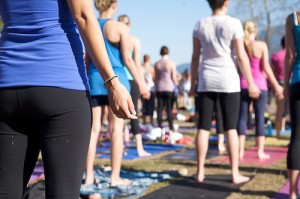by Michelle Sutton-Kerchner
You hit the exercise equipment, whizzing through at record speed. You pump iron, progressively increasing weight. Each day, you feel stronger and healthier. So, how did you pull your back when moving a bag of groceries …
There is no medical mystery behind this misery. It happens every day from doing everyday activities. Think of the happy vacationer who arrives at the beach only to temporarily cripple himself when wrenched by a wave. He spent the year creating a beach-ready body–with the abs and biceps to prove it– only to have a splash wash it away.
Train for Life

There are many ways to train. To lose weight, overcome injury, rehabilitate from surgery, and improve athletics are some of the most popular. Yet, we often don’t give credit, let alone workout time, to what our bodies accomplish on a daily basis. Life is filled with opportunities to strengthen or struggle. Endurance isn’t only for the long-distance runner. Consider all the times you’ve rushed to catch a train while weighed down with carry-alls, or a school bus while toting a backpack, lunch box, and small person attached to you.
When the day itself is a marathon, a pulled neck during a routine shampooing shouldn’t be a surprise. The result of all that twisting, pulling, and yanking during life’s little activities has to release somewhere.
Functional fitness consists of practical exercises that train the body to better accomplish real-life movements. Unfortunately, you can’t create the perfect scenario every time you reach, lift, or even sneeze, along with a personal trainer or fitness instructor shadowing each move. You can help muscles communicate, to work in unison, through an exercise program focused on functional training.
United We Remain Standing
When muscles work together, they better support our joints. They render us more capable of standing unshaken as our day rushes past. The goal of functional training is to join muscles in their work. It takes an integrated approach to strengthen the body as a whole, rather than through isolated muscle groups.
Although it is beneficial to isolate muscles when specific strengthening or rehabilitation is needed, it is essential to help them work interdependently. Face the day as a unified being, balanced in mind and entire body.
Perform exercises that possess the carry-over factor. Modify them to mimic your usual physical activities. Pause training for the big race or a tournament game. Dedicate some workout time to training for real life.

Exercise kinesiologist Paul Chek, founder of the Corrective High-performance Exercise Kinesiology Institute in California, advises standing on your own feet and supporting your weight to achieve true functional exercise. Step away from the fitness machines and benches for a session. Incorporate work that requires activation of stabilizer muscles in the core, arms, and shoulders.
Focus on improving your balance. Perhaps return to basics and go weightless, using your own body as a workout device. Challenge your body to control and balance its own weight, then increase to dumbbells. Teach the upper and lower body to work in unison. Sound simple, Fitness Guru? Try doing a one-legged squat without tumbling down. Room for improvement?
Don’t belittle your impressive strength by lacking the stability of muscles working in harmony. Mange fluidity and control of your movements, and manage an injury-free walk with your leashed hyperactive dog, a trip to the park to swing your grandchild without a stiff upper body for the week’s duration. Ideally, the burden of every activity should be evenly distributed over a muscularly unified body.
Unwind the Day
Regional Fitness Manager Ronald J. (RJ) Pietrucha emphasizes the need to counteract how we pass the day. He notes the sitting position as one of the biggest culprits of dysfunctional movement. “Many people spend a large part of their day sitting, which shifts the body’s alignment and tightens muscles. Functional exercises are needed to compensate that reality and counteract damage,” informs RJ.
Do more with less effort by strengthening and stretching your body. It will be ready for optimal movement with minimal fatigue. RJ recommends incorporating these four corrective exercises into your daily routine:
The Bridge: Lay on your back with knees bent. Thrust hips to the ceiling while tightening glute muscles (squeeze that butt). Perform three sets of ten, or hold for 30 to 60 seconds. This exercise strengthens glute muscles to offset a day spent sitting at a desk or glued to a chair during meetings. Avoid “the spread” while preparing your body to better accommodate life’s activities.
The Bridge simultaneously stretches your hip flexors. Extended sitting is again the culprit– this time of tightened hip muscles. By actively stretching hip flexors, you are better able to keep hips aligned. This helps avoid low back strain and pain. Now, lift that bushel of laundry! We dare you.
The Plank: Lie face down, resting on your forearms with palms flat on the floor. Lift off the floor, raising onto toes and resting on elbows. Be sure your back is flat, parallel to the floor. Tighten glutes. You should form a straight line from head to heels. Hold for 20 to 60 seconds, lower and repeat for three to five reps.
The Plank builds endurance in the abs, back, and stabilizer muscles. It strengthens the core and properly works the entire muscle group that supports the spine, including the cervical spine. This is a lengthening stretch, excellent after sitting to realign posture.
The Wall Slide: Redeem yourself from all the time spent behind the wheel, hunched over a keyboard, or (admit it) in front of the TV. Stand with your back to the wall, heels touching the baseboard, and everything against the wall. Lift arms at 90-degree angles on either side of you, with palms open and facing out. Extend them straight up, sliding arms against the wall.
A double-shot, this exercise strengthens the backs of your shoulders with the wall as a reference point. At the same time, you accomplish a much-needed stretch of pectorals and other upper body muscles. Undo a day’s worth of slouching!
The Hip Hinge: Everyone knows the proper way to lift an object is to” bend at the knees.” But, we often forget to hinge at the hips. This requires your bottom and hips to extend behind you during aforementioned knee bending. This fluid movement of bending while extending up and out requires all muscles to work in unison. Muscles involved in the common movement of bend-and-lift are protected. Those “cannot-straighten-my-back!” moments are avoided.
Do More with Less Effort
Properly using muscles avoids injury, on the Exercise Floor and in the living room. Multitask your fitness program to improve performance. Make everyday movement an opportunity to strengthen, not a threat for injury. Build a body that feels good to live in.
It’s your life. Shouldn’t you train for it?
Source
“Working out for Real Life Functions, by Gina Shaw at www.webmd.com.
Image Credits
Sweeping sneakers (introductory photo): http://www.flickr.com/photos/donger/54354784/
Sore neck: http://www.flickr.com/photos/aidan_jones/3117187373/
Standing tall: http://www.flickr.com/photos/lululemonathletica/6192187357/
 Fitness & Wellness News Your Source for Fitness News, Wellness News, Health News, and Nutrition News!
Fitness & Wellness News Your Source for Fitness News, Wellness News, Health News, and Nutrition News!



